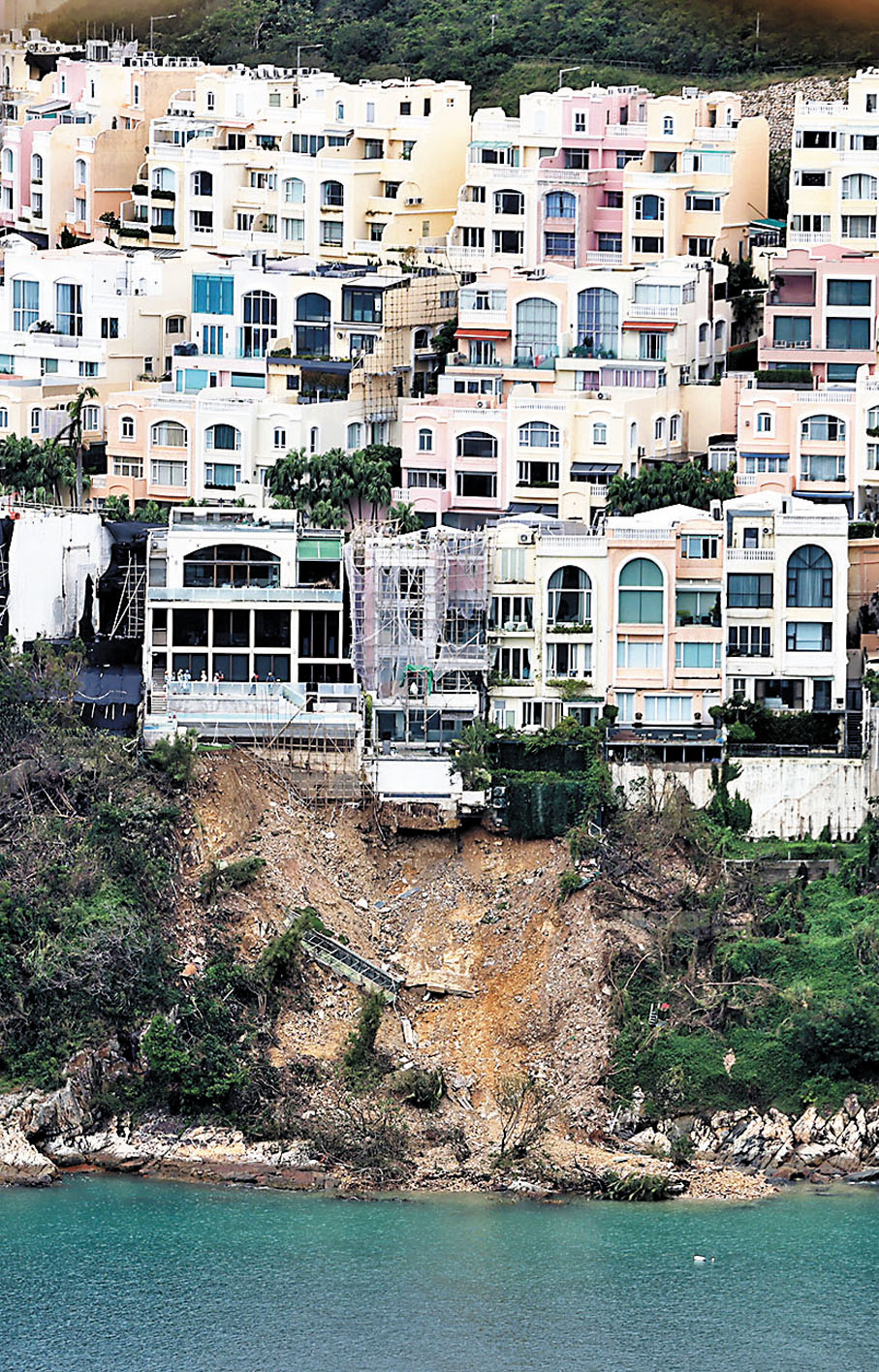【社評雙語道】增處罰升阻嚇力 打擊僭建更高效

【原文】下文摘錄自9月23日香港《文匯報》:
早前「世紀黑雨」引發多處山泥傾瀉,港島豪宅紅山半島有4間獨立屋,被揭發涉及僭建和非法佔用政府土地。屋宇署及地政總署於9月22日開展聯合行動,發現85間臨海獨立屋中,約70間初步懷疑有僭建物,約40間獨立屋初步懷疑有非法佔用政府土地,情況極為嚴重。紅山半島僭建問題引起社會廣泛關注,政府必須嚴正執法,同時要積極檢視現行法例打擊僭建的不足之處,必要時透過修例,增強執法阻嚇力。
黑雨之後,有專業人士對照政府的圖則和紅山半島的航拍照片,指涉及僭建的遠不止4間獨立屋,政府9月22日的行動,發現更多懷疑僭建物,可見紅山半島僭建相當普遍。
事實上,本港現行法例對僭建和非法佔用政府土地的罰則不算輕。以僭建為例,對於無合理辯解而沒有遵從清拆令的業主,一經定罪最高可處罰款20萬元及監禁一年,並且罪行持續的每一天可另處罰款2萬元;非法佔用政府土地者,不遵守地政總署通知,首次定罪的最高罰款額為50萬元及監禁6個月,並且每一天可另處罰款5萬元。
為何罰則不輕,但僭建問題仍然普遍?一方面,政府巡查次數不多,助長業主的僥倖心理,今次紅山半島僭建事件也因百年一遇的黑雨才被揭發;另一方面,執行上有難度、時間長。政府現時發出清拆令的也僅是4間獨立屋,其餘的會按照「風險為本」處理,待接獲投訴及有證據後再跟進。紅山半島新發現懷疑有僭建的獨立屋,政府要逐一搜集證據,需時難以估算。加上部分業主不合作、拒不開門,政府要向法庭申請手令入屋搜證,程序更長。
待政府發出清拆令之後,業主只要拆除,一般無須負上刑責;業主不拆除,只會被「釘契」,業主復原後則可以賣樓。已證實僭建的紅山半島72號屋,早在2001年曾因僭建被「釘契」,清拆僭建後於2006年解除「釘契」並轉手。現時紅山半島僭建、佔用官地如「公開的秘密」,證明法例阻嚇力不夠。
審計署調查報告曾指出,政府在確認舉報至發出清拆令的時間太漫長,待清拆的僭建物堆積如山。按發展局2018年提交立法會的數據,等待拆除的僭建物高達2萬多個。曾有立法會議員笑指,本港需100年才能完成處理已累計的逾80萬宗僭建個案。
要改變僭建氾濫、視法律如無物的現狀,關鍵在於強化打擊僭建的法律力度,簡化處罰過程。例如政府可以訂立法例,只要確認有僭建物,就直接按照其規模實施處罰,有關罰款應更具阻嚇力,且只需透過簡易程序定額罰款,無須上法庭,提高處理僭建的效率。
Enhance the deterrent effect of penalties to combat UBWs more effectively
【譯文】Unauthorised Building Works (UBWs) and unlawful occupation of government land were discovered in four houses of Redhill Peninsula, a luxury housing estate on Hong Kong Island, in the wake of the landslides caused by the “once-in-a-century” black rainstorm earlier. The Buildings Department (BD) and the Lands Department (LandsD) launched a joint operation on 22 September and found that among the 85 houses on the waterfront, about 70 were suspected of having UBWs and about 40 were suspected of unlawful occupation of government land, which is a very serious situation. The problem of UBWs at Redhill Peninsula has aroused widespread concern in society. The Government must enforce the law rigorously and, at the same time, proactively review the inadequacies of the existing legislation in combating UBWs, and where necessary, amend the legislation to enhance the deterrent effect of law enforcement.
Having compared government plot plans and satellite images of Redhill Peninsula after the black rain, some professionals claimed that much more than four houses were suspected of UBWs, and the Government's operation on 22 September discovered even more suspected UBWs, which showed that UBWs are quite common at Redhill Peninsula.
As a matter of fact, the penalties for UBWs and unlawful occupation of government land under the existing laws of Hong Kong are not light. Take UBWs as an example, an owner who fails to comply with a removal order without reasonable excuse is liable upon conviction to a maximum fine of $200,000 and one year's imprisonment, and to a further fine of $20,000 for each day that the offence continues; a person who unlawfully occupies government land and fails to comply with a notice issued by the LandsD is liable on the first occasion on which the person is convicted of the offence, to a fine of $500,000 and to imprisonment for 6 months, and to a further fine of $50,000 for each day during which the offence continues.
Why is the problem of UBWs still prevalent even though the penalties are not light着 On the one hand, the Government's infrequent inspections have fuelled the mentality of owners to count on luck, and the UBWs at Redhill Peninsula were discovered only because of the once-in-a-century rainstorm. On the other hand, there are difficulties in enforcement and it takes a long time. At present, the Government has only issued removal orders for four houses, while the rest will be dealt with under a "risk-based" approach and will be followed up upon receipt of complaints and evidence. It is difficult to estimate the time required for the Government to collect evidence against each of the houses at Redhill Peninsula with suspected UBWs. In addition, as some owners are uncooperative and refuse to open their doors, the Government needs to apply to the court for a warrant to enter the premises to search for evidence, which is an even longer procedure.
After the Government issues an order for the removal of UBWs, the owner will not be held criminally liable as long as he/she removes the UBWs; if the owner does not remove the UBWs, an encumbrance will be constituted on the property title, and the property cannot be transacted until the removal order of UBWs is complied with. House No.72 at Redhill Peninsula was imposed an encumbrance in 2001 because of the UBWs, but the encumbrance was lifted in 2006 after the removal of the UBWs and the property was sold to another owner. The UBWs and occupation of government land at Redhill Peninsula is now “an open secret”, proving that the deterrent effect of the law is insufficient.
The Audit Commission's investigation report once pointed out that the time between the Government's confirmation of the report and the issuance of an order for the removal of UBWs was too long, and there was a backlog of the UBWs. According to the data submitted by the Development Bureau to the Legislative Council in 2018, as many as 20,000 UBWs are to be removed. A LegCo member once laughed that it would take 100 years to deal with the accumulated 800,000 cases of UBWs in Hong Kong.
The key to changing the current situation where UBWs are rampant and some owners have no regard for law, lies in strengthening the law against UBWs and streamlining the process of imposing penalties. For example, the Government can enact legislation to impose penalties directly according to the size of the UBWs once they are confirmed, the fines should be high enough to be deterrent, and a fixed penalty can be imposed through summary proceedings, so as to enhance the efficiency of handling the UBWs.
◆Tiffany
